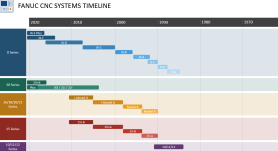Ox
Diamond
- Joined
- Aug 27, 2002
- Location
- Northwest Ohio
I have an old lathe with a first generation "0" control on it, and it sucks to say the least.
Things got a bit better when I by chance stumbled upon the library.
"Whoa, a library! How'd I git here? What keystrokes did I just make?"
So I picked up a mill recently that has a 0D on it as well, but it is 10 yrs newer than that lathe, and I ass_u_med that from the opperator end, that it would be like other current model variants. I expected that it was lacking in axis capacity, expandability, and similar things that I as an opperator wouldn't even see/know.
I was wrong!
So then my wonderment went to "OK, would an 0i be what I am expecting?"
As it had come up in another thread recently, I take it that the answer to that is "no"?
So, my question is - what mills are available with the equiv of a 16/18 or i versions of the same?
I have five 16/18/and 18i's. I know them and I like them. (all lathes)
I now understand what everyone that hates Fanuc is talking about.
I am mostly interested in used machines here...
Did Hardinge offer any mills with an 18 or whatnot on it?
Doo I need to be looking at some other flavours?
I have started to replace my Siemens mills and I want Fanuc's on whatever comes int he door, but I'm not dealing with this Schidt for long.
What is a "21"?
Is that possibly what I am expecting?
Would I be happy with one of those?
Did / doo they put those on mills?
Only place that I am sure that they are on is 2x lathes, so ???
------------------------
Think Snow Eh!
Ox
Things got a bit better when I by chance stumbled upon the library.
"Whoa, a library! How'd I git here? What keystrokes did I just make?"
So I picked up a mill recently that has a 0D on it as well, but it is 10 yrs newer than that lathe, and I ass_u_med that from the opperator end, that it would be like other current model variants. I expected that it was lacking in axis capacity, expandability, and similar things that I as an opperator wouldn't even see/know.
I was wrong!
So then my wonderment went to "OK, would an 0i be what I am expecting?"
As it had come up in another thread recently, I take it that the answer to that is "no"?
So, my question is - what mills are available with the equiv of a 16/18 or i versions of the same?
I have five 16/18/and 18i's. I know them and I like them. (all lathes)
I now understand what everyone that hates Fanuc is talking about.
I am mostly interested in used machines here...
Did Hardinge offer any mills with an 18 or whatnot on it?
Doo I need to be looking at some other flavours?
I have started to replace my Siemens mills and I want Fanuc's on whatever comes int he door, but I'm not dealing with this Schidt for long.
What is a "21"?
Is that possibly what I am expecting?
Would I be happy with one of those?
Did / doo they put those on mills?
Only place that I am sure that they are on is 2x lathes, so ???
------------------------
Think Snow Eh!
Ox
Last edited:



